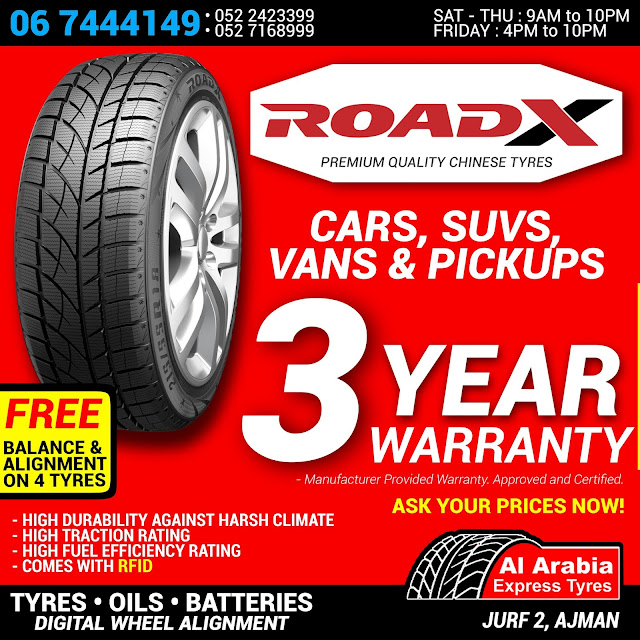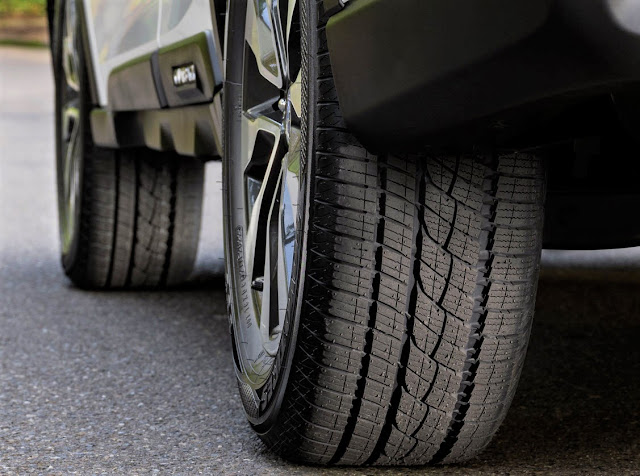Ten Tyre Care Tips
- Get link
- X
- Other Apps
Ten Tyre Care Tips

It’s easy to forget that tyres are the only point of contact between your vehicle and the road. That is why it’s extremely important to preserve the quality and performance of your tyres to ensure both your safety and your mobility. To do so, we advise that you comply with the following recommendations.
1. Contact Patch
A BIG JOB FOR A SMALL AREA
The part of your tyre that’s actually in contact with the road is only about the size of your hand. Your safety, comfort and fuel economy depends on that very small area. Make sure you not only select the right tyres, but also regularly maintain them to ensure they perform at their best. It’s important because your tyres:
- Are the only link between your vehicle and the road
- Carry the entire weight of your car, a load of up to 50 times their own weight
- Respond to driving inputs such as steering, acceleration and braking from the car to the road surface
- Absorb every obstacle on the road
2. Tyre Wear and Depth and Performances
All tyres do not offer the same performances between them when they are new these performance differences increase as tyres wear. Cutting edge technologies developed by the research and development teams at Michelin, allow us to offer a level of perfromance and grip close to new tyres during their whole life all the way down to the legal wear limit. Due to this level of performance, replacing tyres prematurely is not guaranteed to lead to a gain in safety and performance, and there is the obvious financial cost but also an enviromental cost to consider.
The legal minimum tread depth in UK is 1.6 mm across the central three-quarters of the tread width and round its entire circumference. Check the depth of the main tread grooves in several places across and around the tyre, using the gauge as instructed by its manufacturer. Tyres also have tread wear indicators moulded into the base of the main grooves. When the tread surface is worn to the same level as these indicators, the tyre is at the legal limit and should be replaced.
The legal minimum tread depth in UK is 1.6 mm across the central three-quarters of the tread width and round its entire circumference. Check the depth of the main tread grooves in several places across and around the tyre, using the gauge as instructed by its manufacturer. Tyres also have tread wear indicators moulded into the base of the main grooves. When the tread surface is worn to the same level as these indicators, the tyre is at the legal limit and should be replaced.
However you check your tyre tread depths, if they are approaching the legal limit or if you have any doubts, get them checked professionally by a tyre specialist.
3. Tyre Pressure
CHECK YOUR TYRE PRESSURE EVERY MONTH
Correct tyre pressure reduces the risk of losing control of your vehicle. It also protects your tyres from premature wear and irreversible damage to the internal construction. Tyre pressure can drop due to small perforations, the natural escape of air through the tyre's components, or even from a decrease in ambient temperatures. Check the pressure of your tyres, including your spare, monthly and before any long journey, preferably when your tyres are cold (not having run for at least 2 hours or having run for less than 2 miles at low speed). If they are not checked in this cold condition, add 4 to 5 PSI (0.3 bar) to the recommended pressure, but never deflate a hot tyre. It's important to check the pressure once a month, because:
- Under or over inflation can reduce the life of your tyres, affect their performance and increase the risk of damage.
- Correct tyre pressure will even save fuel

- in the user manual of your vehicle
- or on a label on the door or door frame of the vehicle
- or on the inside of the fuel flap
The recommended tyre pressure is NOT located on the tyre. The inflation pressure shown on the tyre sidewall is the maximum tyre inflation pressure.
4. Balancing
KEEP YOUR BALANCE FOR LONGER TYRE LIFE
 Balancing helps prevent premature wear of your tyres and eliminates vibration. It also protects the suspension, steering system and bearings of your vehicle. Have your wheels balanced when a tyre is replaced, a balance weight is moved or removed, or you purchase new tyres. You’ll know a wheel is out of balance when one area is heavier or lighter than the rest. This will cause:
Balancing helps prevent premature wear of your tyres and eliminates vibration. It also protects the suspension, steering system and bearings of your vehicle. Have your wheels balanced when a tyre is replaced, a balance weight is moved or removed, or you purchase new tyres. You’ll know a wheel is out of balance when one area is heavier or lighter than the rest. This will cause:- Uneven and rapid tread wear
- Vibration
- More stress on front-end parts
- Front-end parts to wear prematurely
5. Wheel Alignment
It's difficult to tell if your wheels and axles are correctly aligned while driving. But if your vehicle's suspension geometry is incorrect, its handling may be altered and your safety compromised. If your tyre has come into contact with a solid object, such as a kerb or pothole, or you have noticed uneven wear on your tyres, please go to a tyre specialist to have it thoroughly inspected. It's important to ensure correct alignment to:
- Get the best road handling
- Protect your tyres from irregular and/or rapid wear
- Save fuel
6. Rear Tyres
FOR COMPLETE CONTROL, FIT YOUR NEW TYRES TO THE REAR AXLE
Rear wheels are not connected to your steering wheel, which makes it extremely difficult to judge their grip while driving. We recommend that new tyres or the least worn tyres are fitted to the rear wheels to ensure:
- Better control in emergency braking or tight corners when the roads are slippery.
- Less risk of losing control of your vehicle, especially on wet surfaces
- Better road holding, particularly in difficult situations, whether your car is front or rear wheel drive
7.Tyre Valves
VALVES AND VALVE CAPS PROTECT YOU AND YOUR TYRES
 Valves and their components are ordinarily made of rubber, so they are subject to deterioration over time. Replacing them when you buy new tyres is an inexpensive way to protect your tyres, vehicle and yourself. At high speeds, a cracked, deteriorated rubber valve stem can bend from centrifugal force and allow air loss. The valve cap is also important. It’s the primary air seal and helps to keep out dust and dirt particles. You should check that your valves and valve caps are in good condition to:
Valves and their components are ordinarily made of rubber, so they are subject to deterioration over time. Replacing them when you buy new tyres is an inexpensive way to protect your tyres, vehicle and yourself. At high speeds, a cracked, deteriorated rubber valve stem can bend from centrifugal force and allow air loss. The valve cap is also important. It’s the primary air seal and helps to keep out dust and dirt particles. You should check that your valves and valve caps are in good condition to:- Maintain an airtight seal
- Maintain the correct tyre pressure
- Ensure longer tyre life
8. Handling and Storage
KEEP YOUR TYRES OUT OF HARM’S WAY
Even when they’re not being used, tyres can find themselves in hazardous terrain. Unless they are assembled and inflated, tyres should never be stored in stacks for long periods of time and you should avoid crushing the tyres under objects. It’s extremely important to keep stored tyres away from any flame, any other heat source or any substance capable of causing sparks and/or electrical discharges (i.e. battery generators). When handling tyres, it’s also recommended that you wear protective gloves. Tyres should be stored:
- In a ventilated, dry and temperate area, protected from direct sunlight and precipitation
- Away from any chemicals, solvents or hydrocarbons
- Away from any object capable of penetrating the rubber (pointed metal, wood, etc.)
9. Tyre Repairs
FIRST STEP TO TYRE REPAIR? CALL A PROFESSIONAL.

When a tyre needs repairing, it’s essential to have a tyre specialist remove the tyre from the wheel and inspect it from the inside. This is necessary because internal damage is not visible while the tyre is mounted to the wheel. A tyre specialist will:
- Ensure compliance with procedures for assembly, disassembly, balancing and inflation of the tyre, and the replacement of the valve.
- Verify the internal condition of the tyre, detecting any damage not visible on the surface.
- Ensure the tyre is refitted correctly, optimising handling and comfort.
- Ensure compliance with manufacturer's and legal rules in the choice of tyres: structure, size, speed code, load capacity rating.
- Ensure compliance with the vehicle manufacturer's recommended pressures.
- Take account of the instructions and warnings on the tyre sidewalls (rotation direction or assembly direction).
- Take account of the characteristics of specific tyres (low section height, run-flat, self - sealing tyres, etc.).
10. Service Life
KNOW WHEN TO REPLACE YOUR USED TYRES
Accurately predicting the serviceable life of any specific tyre in advance is not possible. A tyre is composed of various materials and rubber compounds that affect its performance. Its performance also depends upon many other factors such as weather, storage conditions, and conditions of use. That's why we strongly encourage drivers to regularly inspect their tyres to identify anything which means that the tyre needs to be removed from service.
As well as regular tyre inspections and maintenance, drivers should:
- Have tyres that have been in use for five years or more inspected by a specialist at least annually.
- Follow the vehicle manufacturer's tyre replacement recommendation.
- Replace tyres still in service ten years or more from the date of manufacture with new tyres, even if they appear serviceable and even if they have not reached the legal wear limit.
Article Source : Michelin Tyres
Al Arabia Express Tyres Change & Trading L.L.C
- Get link
- X
- Other Apps



Comments
Post a Comment